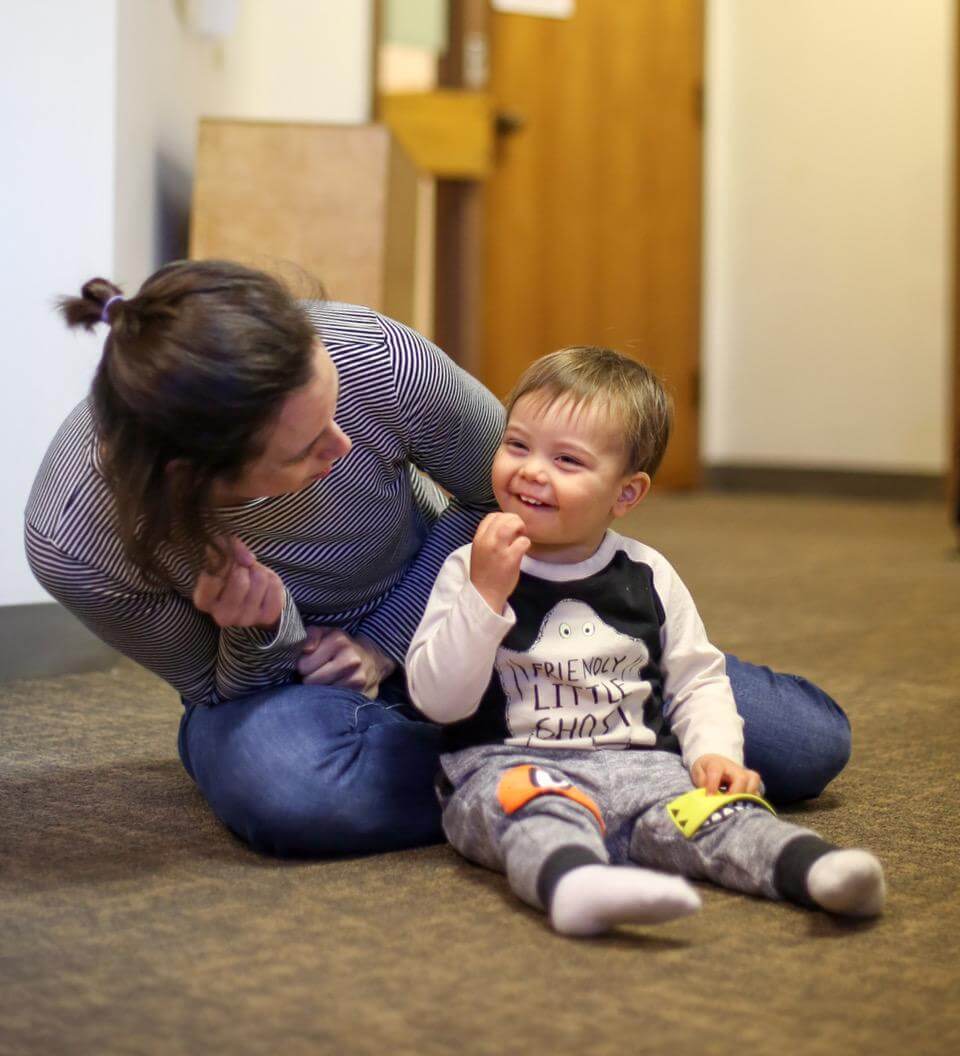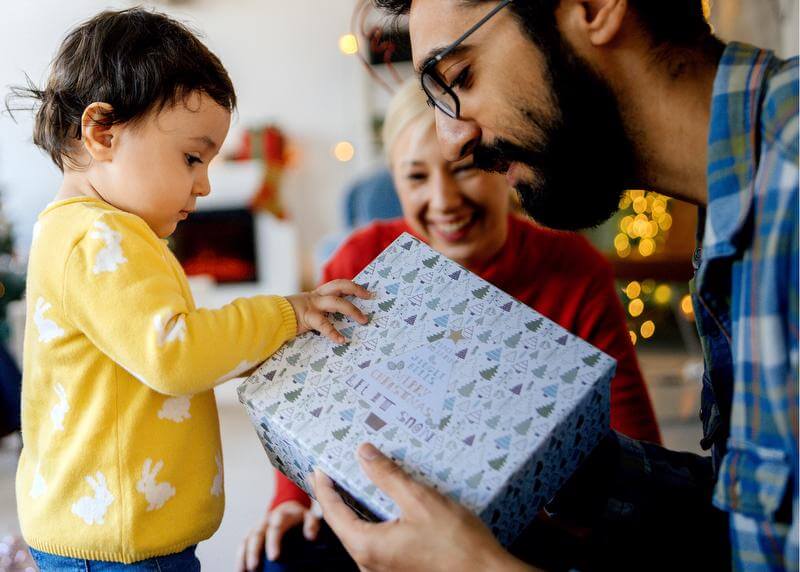Music Together®: Exploring Music and Movement with Your Child
Silver Michelsen February 22, 2023
Summary
Like walking and talking, making music is a skill: a skill that any child can practice given the opportunity! When infants and young children are given the chance to experience musical activities in a fun, judgement-free environment, they’re able to develop a foundational understanding of rhythm and tone. As they grow older, they’ll have the basic skills and confidence they need in order to participate in music however they’d like, be that taking formal piano lessons or singing along to the radio with their friends.
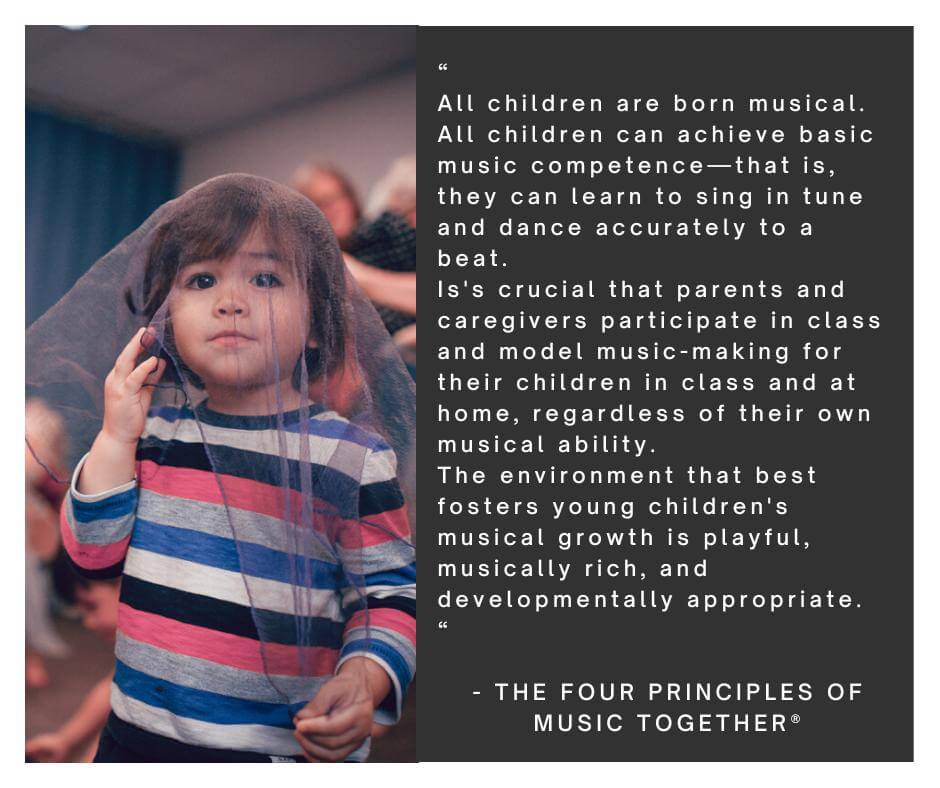
Singing, dancing, and playing with instruments are also great ways to support the development of other early childhood skills. Many of these can be practiced at home, but there are additional benefits to making music with larger groups, such as at family gatherings, daycare circle time, or a dedicated play based music class.
Language
The repetitive nature of songs, chants, and rhymes gives infants a chance to practice adjusting the rhythm, pitch, and sound of their vocalizations to match what they hear. When toddlers are still struggling to make themselves understood, singing is a low-stakes opportunity to practice words and increase vocabulary. Songs also help older kids start to recognize patterns in aspects of language such as rhyme, alliteration, and word length.
Motor Skills
Playing with small instruments such as egg shakers and rhythm sticks supports fine motor development, while dancing with scarves or twirling in a tutu supports large motor development. Of course, you can also always clap, tap, march, and dance with just your body! Moving to music gives kids a chance to practice physical restraint and timing as they try to match the shape, volume, and rhythm of the grown-ups’ movements.
Social Emotional
Many children’s songs encourage dramatic play by describing stories and movements that are lots of fun to act out. Many others encourage emotional literacy by describing scenarios and the way characters feel in reaction to them. It can be quite comforting to know a song that describes something you’re feeling! Children can also develop self-confidence and self expression by leading dances for other people to copy, or making up their own verses to familiar tunes.
Cognitive and Executive Function
When children make music with a group, they practice skills such as paying attention, imitating others, and waiting for the right moment to perform an action. Unlike in many other group environments, though, there is no negative consequence to clapping out of time or forgetting a song, so play-based music classes give young children a chance to practice these skills in their own time, in a low-stakes environment. When kids are allowed to participate, when and how they choose, they learn through positive reinforcement that it’s actually really fun to watch, listen, and follow along!
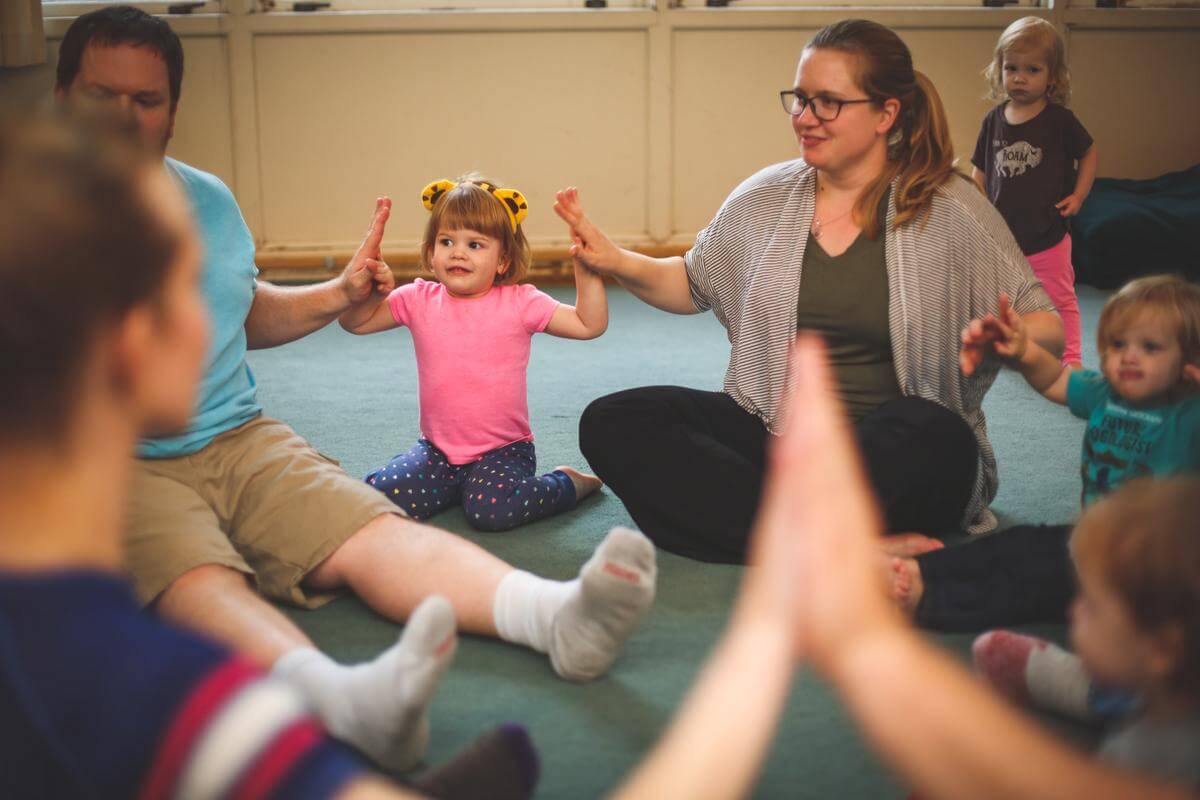
Kids learn by watching and copying, especially from their parents and other caregivers with whom they spend most of their time. This means that the best way to support your child’s learning is to sing, dance, and play with them! Here are some simple activities you can try at home.
Sing About What You Are Doing
Making up songs about the little tasks you do with your child is a great way to bring music into your busy day. You can improvise melodies or rhymes if you want, but describing your actions or repeating one line to the tune of a familiar classic works just as well! For example, you could use the tune of Row Row Row Your Boat to sing:
Change, change, change your diaper
Change your dirty diaper
Change, change, change your diaper
Let’s get a fresh new diaper
Kids love to feel included, so singing about what they’re doing can make them feel like they’re special and the things they do are important. The song can also help your kid stay engaged in the activity, or remember the steps to a task. I sing a hand washing song with my preschooler that goes like this:
Tops and bottoms, tops and bottoms
In between, in between,
Rub them all together, rub them all together
Now they’re clean, now they’re clean
Your words don’t have to fit the rhythm perfectly, or even stay in one key; it’s actually a good idea to mess up on purpose sometimes even if you’re a professional vocalist, to show your child that it’s ok to stumble or sound discordant! Your child gets plenty of opportunities to hear pitch- perfect recorded music; your purpose is to show your child that creating music can be something fun, something that they can do either on their own or with the people they love. Music isn’t just about the end product, it’s about playing around and experimenting!
Play With A Shaker
(If you don’t have maracas or egg shakers, there are plenty of ways to make a shaker at home! Fill a small water bottle halfway with water or beans, then hot glue the lid closed. Dump a handful of uncooked rice into a tupperware or jar and put the lid on, then just dump them back out when you’re done. Collect spare buttons, beads, and coins into a small cardboard box and tape it shut. The possibilities are endless! Just make sure you don’t leave your child with any shaker that hasn’t been totally child-proofed.)
Hold onto a shaker yourself so you can lead by example, and give your child a shaker of their own to experiment with. Try just setting a steady beat with your shaker while you sing or chant several verses of a song. Then try a bigger, slower beat, shaking just once or twice a line, or a small, fast beat. More complex patterns can be fun, but make sure you’re giving your child plenty of time to experience the basics, as well! If you want to mix it up, there are lots of different fun ways you can hold the same steady beat using a shaker:
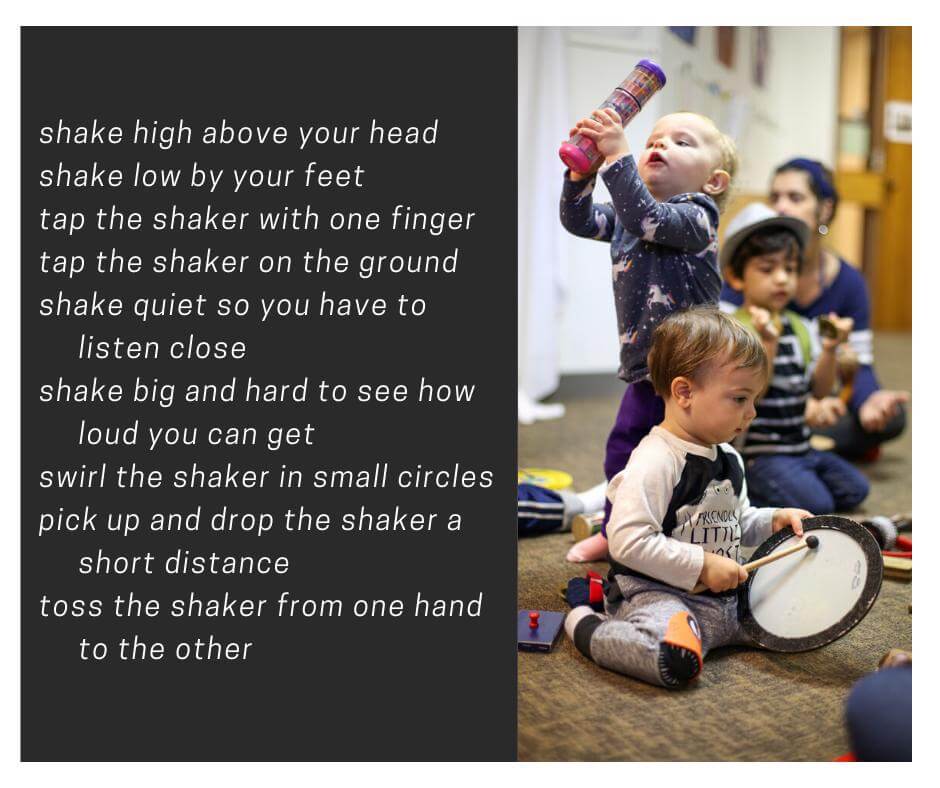
It’s tempting to hold onto your infant’s hands to help them move the shaker in time, but it’s important to let them experiment on their own. If they just want to sit and watch, they are learning a lot about what a steady beat looks and sounds like. Then, when they’re ready to try it themself, their hands are free to do so. By listening to the sound their shaker makes and comparing it to what they were imagining and to your beat, they learn about cause and effect. As their ability to physically control their movements improves along with their ability to feel and act on a beat, they will learn how to purposefully maintain a rhythm!
(Don’t worry if your beat isn’t perfectly steadily, or perfectly in time with your singing. You may find it easier to hold a beat by marching or counting to yourself, but even then, the most important part is simply that you’re modeling the attempt. No matter how out-of-tune or off-beat you are, your child will still be able to experiment, and practice comparing what they do to what they see and hear. They will learn from you how to practice something that they’re not already perfect at! And you may even find your own sense of rhythm and tone improving, now that you’ve got a judgement-free space in which to practice yourself.)
Some kids love to jump right in and experiment with a toy or activity, while others like to wait and watch until they feel confident that they understand it. Both of these tendencies are great ways to learn about something new! It can be exasperating when a kid is doing everything except the action you expect, or frustrating when a kid doesn’t seem to be participating at all. However, in both of these situations, the best way to support their learning is to keep singing and moving yourself while you let them experience the music in their own way, at their own pace. You may be amazed at what your child can do once they decide they’re ready, as long as you give them the time to prepare! This is why play-based classes are great for young children, as opposed to formal, structured instruction that expects certain behaviors and results.
Put On A Song and Dance
The best way to learn is by doing, the best way to teach is by example, and the best way to support a life of musical talent is to support a life of musical joy. You don’t need to do anything fancy when you dance with your child; just step back and forth, wave your arms in the air, clap, stomp, and spin around! Have fun moving your body to the rhythm, and your child will have fun too.
When I dance with my child, I like to do the same move several times in a row, to give them the chance to watch my move, understand it, and then copy it if they want to. I also like to copy their moves, to show that I’m paying attention to them. It’s quite the confidence boost to see that other people think your dance looks so cool and fun that they want to try it too! Even young infants often love when their movements are copied, delighted that they can affect the actions of the grown-ups around them.
When a child is too young to move much on their own, or just wants to relax and cuddle for a bit, you can hold them while you sway in time, march around, or tap out a beat on their body. This way you’re helping them experience the feeling of the beat, while still leaving them free to experiment, letting them wiggle or clap or move their own body how they’d like.
(Structured dances like Head Shoulders Knees and Toes or The Macarena can teach you some moves and give you a bit of inspiration if you’re not sure where to start. Just remember to let your child dance their own way, which may or may not involve following instructions! These sorts of group dances are a great way for older kids to learn about the fun of voluntary participation in a community activity, or the power of exercising their autonomy and choosing not to participate. Either way, they’re still learning about music and movement, whether they’re following along or listening while they pretend to be a cat on the other side of the room!)
Interested In More Information?
You are your child’s first teacher. If you model a love for music and a willingness to participate and experiment, your child will follow your example! This will look different for every child; some will sing along with you right away, and some will listen quietly for months, then hum to themselves in their room at night. Some will clap their hands and tap their drums, and some will stomp back and forth across the room, falling in and out of rhythm. Some will studiously attempt to follow your every dance move, and some will invent wild new moves for you to follow. Every child learns differently, but every child will develop their innate musical talent if given the chance!
(Recorded music is a great supplement, especially since it allows children to hear all sorts of different kinds of instruments, tonalities, and styles! You can still model an active appreciation and participation by humming along, dancing, or nodding your head and tapping a beat.)
If you’re looking for a little more guidance or community, Music Together® is an international organization that provides play based classes to support the development of foundational musical skills in young children. Meadowlark Music Together, Lawrence’s local chapter, offers weekly 45-minute mixed-age classes for kids from ages 0 to 5 and their caregivers. Join us to learn songs and chants from our curated collections, play with instruments such as resonator bells and rhythm sticks, and have fun dancing with your family and making new friends! Music Together lets children participate at their own pace, in their own style, while they experience music-making as a community event. Whether you’re an experienced musician or still finding your own voice, we’ll support you as you support your child’s musical journey and early childhood development.
Find out more at https://www.meadowlarkmusictogether.com, and keep singing and dancing!
